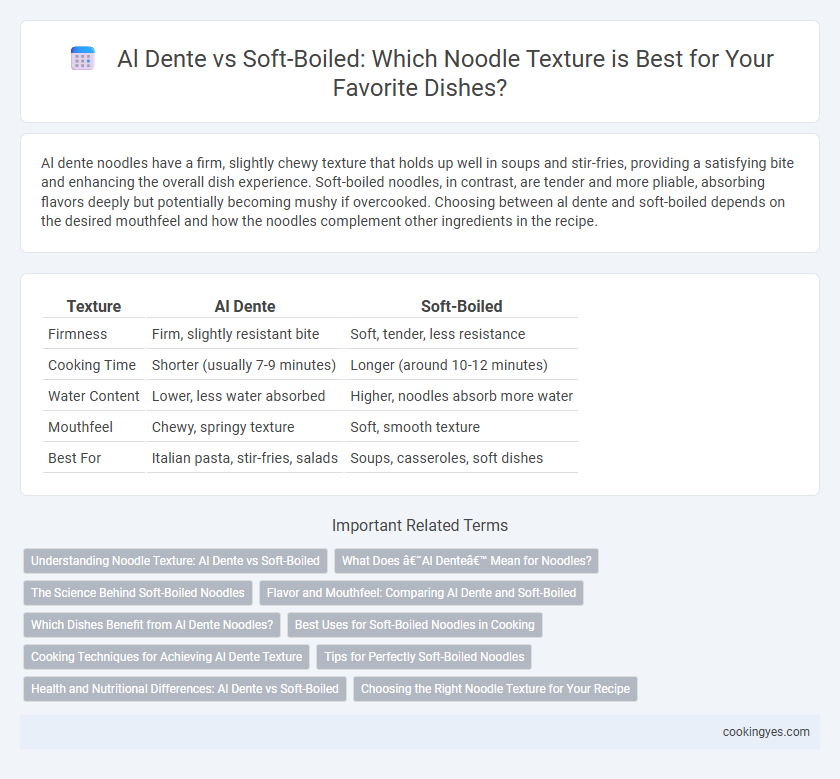Al dente noodles have a firm, slightly chewy texture that holds up well in soups and stir-fries, providing a satisfying bite and enhancing the overall dish experience. Soft-boiled noodles, in contrast, are tender and more pliable, absorbing flavors deeply but potentially becoming mushy if overcooked. Choosing between al dente and soft-boiled depends on the desired mouthfeel and how the noodles complement other ingredients in the recipe.
Table of Comparison
| Texture | Al Dente | Soft-Boiled |
|---|---|---|
| Firmness | Firm, slightly resistant bite | Soft, tender, less resistance |
| Cooking Time | Shorter (usually 7-9 minutes) | Longer (around 10-12 minutes) |
| Water Content | Lower, less water absorbed | Higher, noodles absorb more water |
| Mouthfeel | Chewy, springy texture | Soft, smooth texture |
| Best For | Italian pasta, stir-fries, salads | Soups, casseroles, soft dishes |
Understanding Noodle Texture: Al Dente vs Soft-Boiled
Al dente noodles offer a firm, slightly chewy texture that enhances the overall mouthfeel, while soft-boiled noodles provide a tender, pliable consistency that absorbs sauces more readily. The cooking time and water temperature play crucial roles in achieving these distinct textures, with al dente requiring a shorter boil and immediate draining to prevent overcooking. Texture preference impacts not only taste but also digestion, as firmer noodles retain more structure and softness allows for easier breakdown.
What Does ‘Al Dente’ Mean for Noodles?
"Al dente" means noodles are cooked to be firm to the bite, offering a slightly chewy texture that retains shape without being overly soft. This ideal texture balances tenderness and resistance, enhancing the noodle's flavor absorption and preventing mushiness commonly associated with overcooked, soft-boiled noodles. Al dente noodles are preferred in Italian cuisine for pasta and are increasingly favored in Asian noodle dishes for optimal mouthfeel and texture contrast.
The Science Behind Soft-Boiled Noodles
Soft-boiled noodles retain higher moisture content due to less starch gelatinization, resulting in a tender, pliable texture favored in many Asian cuisines. The lower cooking temperature prevents the noodle's protein matrix from tightening excessively, which keeps the noodle soft and less elastic compared to al dente counterparts. Understanding the molecular changes during soft boiling helps optimize noodle texture for recipes requiring a delicate, smooth mouthfeel.
Flavor and Mouthfeel: Comparing Al Dente and Soft-Boiled
Al dente noodles maintain a firm, slightly chewy texture that enhances the pasta's natural wheat flavor and provides a satisfying bite. Soft-boiled noodles absorb more water, resulting in a tender, smooth mouthfeel that mellows the flavor and complements rich, creamy sauces. Flavor intensity is more pronounced in al dente noodles, while soft-boiled noodles offer a comforting, delicate texture ideal for broths and light dressings.
Which Dishes Benefit from Al Dente Noodles?
Al dente noodles, characterized by a firm and slightly chewy texture, are ideal for dishes like pasta salads, stir-fries, and baked pasta where the noodles must hold their shape and absorb sauces without becoming mushy. Classic Italian dishes such as spaghetti carbonara and penne arrabbiata benefit from al dente cooking, as the firmer texture contrasts beautifully with rich, creamy, or spicy sauces. Soft-boiled noodles, by contrast, are better suited for soups and delicate broths, where a tender, smooth texture enhances the overall mouthfeel.
Best Uses for Soft-Boiled Noodles in Cooking
Soft-boiled noodles offer a tender, slightly chewy texture ideal for dishes requiring noodles to absorb rich broths or sauces, such as ramen and stir-fried recipes. Their softness enhances flavor integration, making them perfect for hearty soups and creamy pasta dishes. This texture ensures a pleasant mouthfeel without overpowering delicate ingredients.
Cooking Techniques for Achieving Al Dente Texture
Achieving the perfect al dente noodle texture requires precise timing during boiling, usually around 1-2 minutes less than soft-boiled noodles to ensure a firm bite. Controlling water temperature and stirring noodles gently prevents overcooking and stickiness, preserving the ideal chewiness. Shock-cooling noodles in cold water immediately after draining halts the cooking process, locking in the al dente texture preferred in many culinary traditions.
Tips for Perfectly Soft-Boiled Noodles
Achieving perfectly soft-boiled noodles requires careful timing; simmer noodles for 4-6 minutes depending on thickness to ensure tender texture without overcooking. Stir noodles gently during boiling to prevent clumping and maintain even cooking. Rinse noodles briefly under cold water immediately after boiling to stop cooking and preserve the ideal soft but firm consistency.
Health and Nutritional Differences: Al Dente vs Soft-Boiled
Al dente noodles have a lower glycemic index compared to soft-boiled noodles, which helps regulate blood sugar levels more effectively. The firmer texture of al dente noodles preserves more resistant starch, promoting better digestive health and increased satiety. Soft-boiled noodles tend to break down more quickly in the digestive system, potentially causing faster spikes in blood glucose and offering fewer dietary fiber benefits.
Choosing the Right Noodle Texture for Your Recipe
Choosing the right noodle texture depends on the dish and cooking time; al dente noodles offer a firm bite that holds up well in hearty sauces and stir-fries, enhancing texture contrast. Soft-boiled noodles provide a tender, delicate mouthfeel ideal for soups and light broths, allowing flavors to blend smoothly. Understanding these differences helps tailor noodle preparation to complement the recipe's overall flavor and consistency.
Al dente vs Soft-boiled for noodle texture Infographic

 cookingyes.com
cookingyes.com